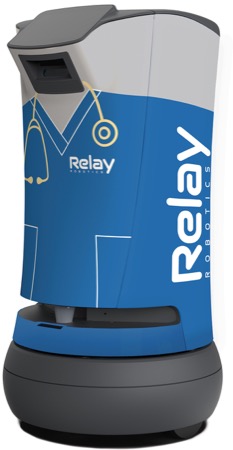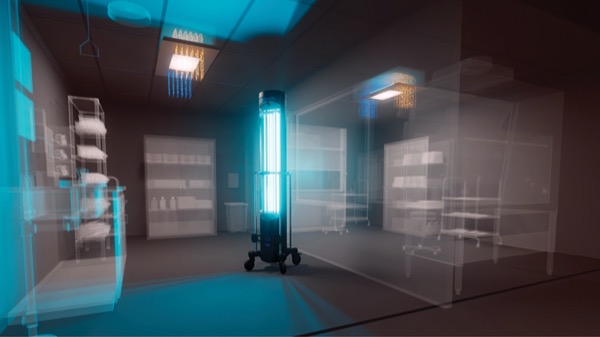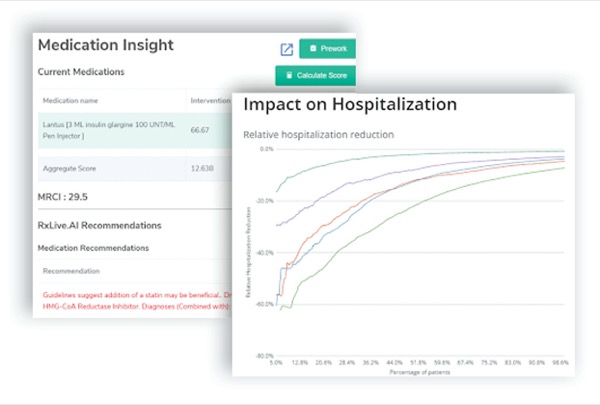Several companies presented technologies at the ASHP 2023 Summer Meetings & Exhibition, in Baltimore, for increasing patient safety and pharmacy efficiency. Among them were a telehealth platform and disinfecting and medication delivery robots. Here is a brief roundup of the highlights, with expert commentary on the potential of each kind of technology.
Surfacide
Surfacide, based in Waukesha, Wis., produces robots that emit ultraviolet (UV) radiation to eradicate microorganisms found in the air or on surfaces in sterile compounding suites. In anticipation of new USP regulations regarding sterile compounding that go into effect in November, the company recently launched a subscription service called SURFrx, rather than requiring capital expenditures for the robots. The company hopes this payment model will improve affordability.
Surfacide’s HELIOS system uses three robots that emit UV-C rays simultaneously and can rotate 360 degrees. It is designed to kill vegetative forms of bacteria along with some fungi and viruses such as SARS-CoV-2. Although it did not use Surfacide products, an independent study of UV-C disinfection technology showed that emitting 254-nm UV rays, the standard used by Surfacide, neutralized more than 99% of SARS-CoV-2 virus (Microbiol Spectr 2021;9[2]:e00537-21).
Robots that use UV radiation to disinfect surfaces, such as Surfacide’s, are becoming more common, said Benjamin D. Galvan, MLS(ACSP), CIC, CPH, the director of infection prevention at HCA Florida South Tampa Hospital. “This June, I attended the [Association for Professionals in Infection Control and Epidemiology] Annual Conference in Orlando, and I’d say it felt like everywhere I looked, there was some form of UV-C technology being promoted,” he said. This was a notable increase from 2022, Mr. Galvan added.
“As an infection prevention professional, it is heartening to see this increased focus on making our healthcare facilities as safe for patients as possible,” he continued, noting that the COVID-19 pandemic spurred imperatives to clean and disinfect that involved fewer people working in close quarters.
Mr. Galvan advised thinking of robots as a supplement to “tried-and-true” infection control measures, such as first cleaning dust and dirt from surfaces and then using disinfecting solutions to eradicate any microbes that might cause infection. The robot could be a final step to ensure that any given space is as germ-free as possible. Mr. Galvan suggested that a robot might prove especially helpful in neutralizing bacteria that are somewhat impervious to disinfectants (Microorganisms 2021;9[12]:2550).
“These products aren’t cheap, so depending on the size of your facility, you might only have one or two of them,” Mr. Galvan said. “There would have to be a prioritization process about where to best deploy a robot.” Depending on a facility’s focus and patient base, he said, such sites might include the sterile compounding suite, operating room or oncology unit.
Relay Robotics
Relay Robotics manufactures robots that can deliver items such as medications or blood specimens within a healthcare facility. The company, based in Campbell, Calif., said this is an innovative solution for persistent shortages of healthcare personnel. To the extent that mundane tasks can be offloaded onto robots, staff can engage in more direct interaction and consultation with patients, according to the company.
The robots can navigate through busy hospital corridors and open elevators themselves, and are designed to carry hazardous drugs safely when needed. Monthly leases are available, and the robots come with 24/7 customer support.

Any robotic device used for healthcare should have an intuitive interface that technicians and patients and their caregivers can easily understand, said Alex Bishop, PhD, a professor of human development and family science at Oklahoma State University, in Stillwater. In addition, the robots need to have robust protections for patient privacy.
“It is always a best practice to keep names off any materials that a robot may be delivering down the hall, like a prescription or blood sample, and also do not openly label dietary information—these are the things that someone might want to protect,” said Dr. Bishop, who specializes in the use of robotics among older people, both at home and in health facilities. Any patient-specific information that underlies the blood sample, prescription or meal tray should be stored in a hack-proof server, he advised.
Pharmacists can assist in developing robots with the capability to detect medications that should not be used together, Dr. Bishop said. Otherwise, a robot will simply deliver any medications that are in a patient’s chart, whether or not there are contraindications for using different drugs together. But programming the robot with artificial intelligence (AI) could help reduce and even prevent such errant deliveries, Dr. Bishop said, potentially averting medication errors. In this scenario, the robot would not deliver any conflicting medications until a human clinician—a pharmacist or physician—has resolved the conflict and determined the delivery is safe.
“AI has great potential for centralizing medication information and keeping people safe,” Dr. Bishop concluded.
RxLive
RxLive is a telehealth platform that enables individual consultations between patients and pharmacists, along with surveillance of trends such as medication nonadherence rates throughout a health system. The software, which health providers obtain by subscription, aims to deliver personal service while simultaneously improving population-level health outcomes.
There are multiple components of the RxLive platform. The telehealth component links clinical pharmacists directly to a patient for consultations, with particular focus on safe use of high-risk medications and effectively managing diabetes, hypertension, and cardiovascular and behavioral health. An informatics platform identifies different possibilities for why patients do not maintain their prescriptions, plus suggestions about closing those gaps. This feature of RxLive also suggests ways to standardize medication delivery throughout a health organization, and identifies in real time when patients are not adhering to a medication treatment plan.
RxLive is just one telemedicine option; others are more homegrown, with a strict focus on telemedicine instead of the additional services RxLive provides.
At the University of California, San Francisco (UCSF), for example, pharmacists deliver telemedicine support via the video conferencing software Zoom. This practice began during the COVID-19 pandemic and continues today.
There’s an ongoing need for training in optimizing the use of platforms such as Zoom for patient care, said Crystal Zhou, PharmD, a clinical pharmacist who specializes in cardiology at UCSF. She and her colleagues recently described UCSF’s experience with telehealth pharmacy in the Journal of Pharmacy Practice (2023;36[2]:350-356).
“Some of our physicians and pharmacists could potentially do physical assessments on Zoom,” Dr. Zhou said, recalling the intensive period of setting up telemedicine services as COVID-19 emerged in 2020. As an example, telling a patient to point their web camera at their leg and then press down with their thumbs could reveal whether there’s a fluid buildup that requires a change in medication, she said. But especially in the early days of the pandemic, some clinicians treated the Zoom appointments like traditional phone calls rather than using the full capabilities of the platform.
Although Dr. Zhou finds that her colleagues are more comfortable with Zoom today, she suggested that greater initial training support could have eased the transition. It was unclear at first how to help patients manage connectivity issues when using Zoom, or deciding when to switch to phone rather than continue the conversation on Zoom because connectivity was too great a challenge.
“We would ask each other about how to handle situations like these. That was helpful, but it would have been nice to have more structured support,” Dr. Zhou said.
For its part, RxLive offers customer support in how to use its product.
The sources reported no relevant financial disclosures other than their stated employment.
This article is from the September 2023 print issue.



